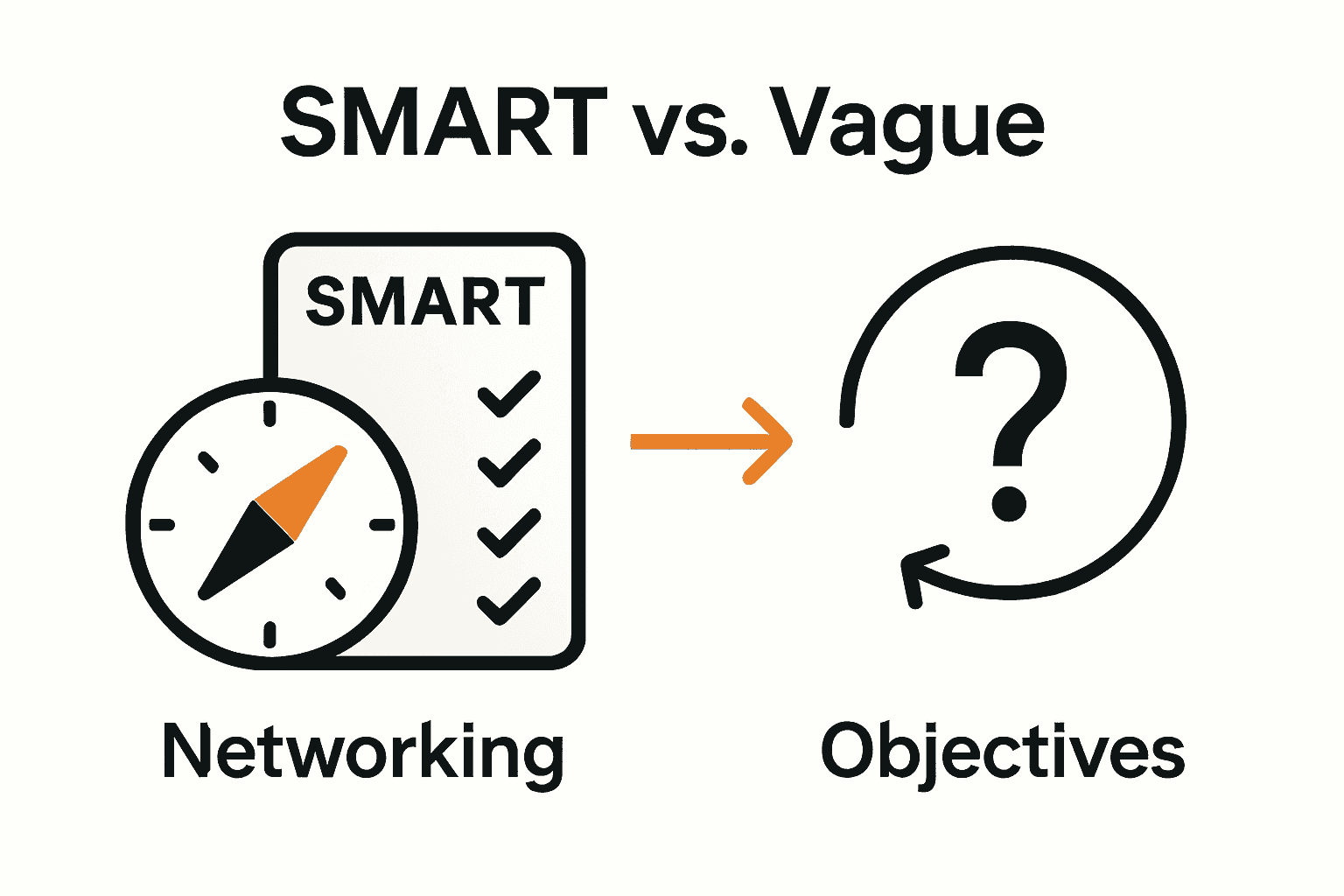Did you know that professionals with clearly defined networking goals are up to 42 percent more likely to see career growth than those without a plan? Connecting with the right people can open doors, but a scattershot approach often leads to missed opportunities and wasted time. By mapping out your objectives and finding strategic contacts, you can transform random interactions into meaningful relationships that actually support your long term success.
Quick Summary
| Key Point | Explanation |
|---|---|
| 1. Define SMART networking objectives | Create specific, measurable, achievable, relevant, and time-bound goals to guide your networking efforts effectively. |
| 2. Identify ideal contacts based on criteria | Research potential connections by defining specific attributes like industry and role to ensure alignment with your goals. |
| 3. Utilize multiple digital channels | Expand your networking reach by engaging on various platforms, such as LinkedIn, Twitter, and industry forums, for diverse opportunities. |
| 4. Engage with value-driven communication | Build relationships by offering insights and showing genuine interest in others’ work before seeking assistance. |
| 5. Systematic organization of connections | Maintain an organized system to keep track of contacts and regularly update information for effective networking. |
Table of Contents
- Step 1: Define Your Networking Objectives
- Step 2: Identify And Research Potential Contacts
- Step 3: Connect Through Targeted Digital Channels
- Step 4: Engage With Value-Driven Communication
- Step 5: Verify And Organize Your Business Connections
Step 1: Define your networking objectives
Networking without clear goals is like sailing without a compass. Your networking journey starts with creating precise, strategic objectives that will guide your professional connections and growth.
Start by thinking about what you want to achieve both in the short and long term. According to research from business networking experts, your goals should follow the SMART framework: Specific, Measurable, Achievable, Relevant, and Time-bound. This means moving beyond vague aspirations like “grow my network” to concrete targets such as “connect with 10 potential industry partners in the next three months” or “establish three collaborative relationships with digital marketing professionals by year-end”.
Break down your objectives into distinct categories. Short-term goals might include attending a specific industry conference, joining professional online communities, or scheduling a set number of networking meetings. Long-term objectives could focus on building thought leadership, developing a global partner network, or positioning yourself as an expert in your field.
Here’s a summary of SMART networking objectives examples:
| Objective Type | Example Objective | Time Frame |
|---|---|---|
| Short-term | Attend 1 industry conference Join 2 online communities Schedule 5 networking meetings | 1-3 months |
| Long-term | Build thought leadership Develop global partner network Position as field expert | 6-12 months |
To track your progress effectively, use tools that help you monitor your networking metrics. This could be a simple spreadsheet, a customer relationship management (CRM) system, or social media analytics platforms. According to research, tracking key metrics like new connections, engagement levels, and potential leads will help you understand the real impact of your networking efforts.
Pro Tip: Always align your networking objectives with your broader business strategy. Your professional connections should serve a clear purpose beyond just collecting contacts.
By defining clear, measurable networking objectives, you transform random interactions into strategic opportunities for growth and collaboration.
 Your next step? Start mapping out those specific, actionable goals that will drive your professional networking forward.
Your next step? Start mapping out those specific, actionable goals that will drive your professional networking forward.
Step 2: Identify and research potential contacts
With your networking objectives clearly defined, the next crucial step is finding the right people who can help you achieve those goals. Think of this process as strategic matchmaking for your professional growth.
According to research on sales intelligence platforms, start by defining your Ideal Customer Profile (ICP). This means getting specific about who you want to connect with by considering key attributes like industry, professional role, company size, and geographic location. Are you looking to connect with digital marketing managers in mid-sized tech companies? Or perhaps startup founders in your local business ecosystem?
Leverage online platforms to conduct your research comprehensively. LinkedIn remains a powerhouse for professional networking, offering detailed professional profiles that can help you understand a potential contact’s background, interests, and professional trajectory. Professional networking sites, industry forums, and conference attendee lists can also be goldmines for identifying potential connections.
Sales intelligence tools can help you go beyond basic profile information. These platforms can provide verified contact details, including email addresses and phone numbers, which can be incredibly valuable when you’re ready to reach out. When researching contacts, look beyond just their job title.
 Pay attention to their professional achievements, shared connections, and recent publications or presentations.
Pay attention to their professional achievements, shared connections, and recent publications or presentations.
Pro Tip: Quality trumps quantity. Focus on finding contacts who genuinely align with your networking objectives rather than collecting random connections.
Remember that research is just the beginning. Your next step will be developing a strategic approach to making meaningful connections with these potential contacts. Take your time, be thorough, and prepare to transform your research into powerful professional relationships.
Step 3: Connect through targeted digital channels
Now that you have identified potential contacts, it is time to strategically reach out and build meaningful professional connections across digital platforms. Think of this step as constructing a digital bridge between your business goals and potential networking opportunities.
According to networking research, LinkedIn remains the premier platform for professional connections. Create a compelling profile that highlights your expertise and unique value proposition. Engage actively by sharing insightful content, commenting on industry trends, and participating in relevant professional groups. As research indicates, these platforms are not just about collecting connections but about creating genuine interactions.
Beyond LinkedIn, explore multiple digital channels to expand your network. Platforms like X (formerly Twitter), Instagram, and industry specific forums offer unique opportunities to connect with peers and potential collaborators. Join online communities where your target contacts are most active. Reddit, Quora, and specialized industry forums can be excellent places to showcase your knowledge and build relationships.
When connecting, focus on quality over quantity. Learn more about multichannel marketing strategies that can help you develop a more nuanced approach to digital networking. Personalize your connection requests with thoughtful messages that demonstrate you have researched their background and understand their professional context.
Pro Tip: Use social listening tools to track conversations and opportunities in your industry. Timing and context can make your networking efforts significantly more effective.
Remember that digital networking is about building genuine relationships.
Approach each interaction with authenticity, provide value, and be genuinely interested in understanding the other person’s professional journey. Your next step is to develop a consistent engagement strategy that turns these initial digital connections into meaningful professional relationships.
Step 4: Engage with value-driven communication
Networking is not about selling or collecting business cards. It is about building genuine relationships where you consistently demonstrate value and create meaningful professional connections.
According to networking research, the most successful professionals approach communication with a generosity mindset. Before asking for anything, focus on what you can offer to your connections. This might mean sharing an insightful industry article, offering a helpful resource, or providing strategic advice that could benefit their work. Check out our guide on digital marketing strategies to understand how providing value can transform your professional interactions.
Engagement goes beyond simple likes or generic comments. When interacting on professional platforms, craft thoughtful responses that show you have truly read and understood the content. Demonstrate your expertise by adding unique perspectives or asking intelligent questions that advance the conversation. Research shows that offering help before seeking assistance builds significant trust and goodwill in networking relationships.
Personalization is key to effective communication. When reaching out to a new contact, reference something specific from their profile or recent work. Explain why you found their perspective interesting and how you might be able to support their professional goals. This approach transforms cold connections into potential collaborative partnerships.
Pro Tip: Always follow up with a thank you message and look for ways to provide ongoing value to your network.
Remember that valuable communication is a two way street. Listen actively, show genuine interest, and be prepared to support others without immediate expectations of return. Your next step is to develop a consistent approach to nurturing these professional relationships with authenticity and strategic generosity.
Step 5: Verify and organize your business connections
Building a professional network is like cultivating a garden. Just as plants need systematic care, your business connections require consistent maintenance and strategic organization.
Research emphasizes the critical importance of maintaining accurate and current contact information. Start by creating a centralized system for storing and tracking your professional connections. Learn more about CRM management techniques that can help streamline your networking efforts. Consider using customer relationship management tools or professional networking platforms that allow detailed contact profiles and interaction tracking.
Each time you connect with a professional contact, take immediate notes about your conversation. Record key details like their professional interests, recent achievements, potential collaboration opportunities, and any personal insights that might help you build a more meaningful relationship. This approach transforms casual connections into strategic professional relationships.
Periodically review and update your contact list. Professional roles change quickly, and contact details can become outdated. Set a quarterly reminder to verify contact information, check LinkedIn profiles, and refresh your understanding of each connection’s current professional landscape. This proactive approach ensures your network remains relevant and valuable.
Pro Tip: Create a simple scoring system to categorize your connections based on potential collaboration, shared interests, and strategic alignment with your business objectives.
Remember that organization is not about collecting contacts but about nurturing meaningful professional relationships. Your network is a living ecosystem that requires consistent attention and strategic cultivation. The next step is to develop a systematic approach to maintaining and growing these valuable connections.
Ready to Build a Stronger Business Network and Achieve Real Results?
Growing your business network as a small business owner can feel overwhelming. Whether you are struggling to set clear objectives, manage your industry contacts, or keep track of follow-ups, it is easy to fall behind. You might have set SMART goals or started using CRM, but find it challenging to organise and maintain real, value-driven relationships that drive growth.

This is where Zoo Digital steps in. Our team helps you move from scattered efforts to a strategic networking system. From expert Hubspot CRM management and setup to digital marketing driven by data, we equip you with tools that transform how you connect, engage, and convert contacts into lasting business partners. Take advantage of a solution tailored for small business success. Visit Zoo Digital today and discover how our services support every step of your networking journey. Make your next business connection count—let us help you build a stronger, smarter network right now.
Frequently Asked Questions
How can I define my networking objectives for small business success?
To define your networking objectives, use the SMART framework: make them Specific, Measurable, Achievable, Relevant, and Time-bound. For example, aim to connect with 10 industry partners within the next three months to track your progress effectively.
What steps should I take to identify potential contacts for my business network?
Start by creating your Ideal Customer Profile (ICP) based on industry, role, company size, and location. Utilize online platforms like LinkedIn to research professionals who fit your ICP—aim to identify at least 15 potential contacts in your desired field.
How do I effectively connect with potential contacts through digital channels?
Craft personalized connection requests on professional platforms like LinkedIn by referencing something specific from the contact’s profile or recent work. Make it a goal to connect with at least five new contacts each week to build momentum in your networking efforts.
What communication strategies should I use to engage my network meaningfully?
Engage with your network by prioritizing value-driven communication, such as sharing helpful resources or asking insightful questions. Aim to follow up with at least one meaningful interaction per contact each month to nurture your relationships.
How can I keep my business connections organized and up-to-date?
Create a systematic approach to organizing your connections by using a centralized tracking system to store contact information and key details about each interaction. Set a quarterly reminder to review and update your contact list to ensure it remains current and relevant.
What types of networking metrics should I track for my small business?
Track metrics such as new connections made, engagement levels with your network, and potential collaboration opportunities. Set specific targets, like increasing your number of meaningful connections by 25% within six months, to gauge the effectiveness of your networking strategy.
Recommended
- How to Build a Marketing Strategy for Small Businesses in 2025 – Zoo Digital
- Digital Marketing for Beginners: 2025 Guide for Small Businesses – Zoo Digital
- How to Start Online Advertising: Guide for Small Businesses 2025 – Zoo Digital
- Creating Business Partnerships for Small Business Growth – Zoo Digital

